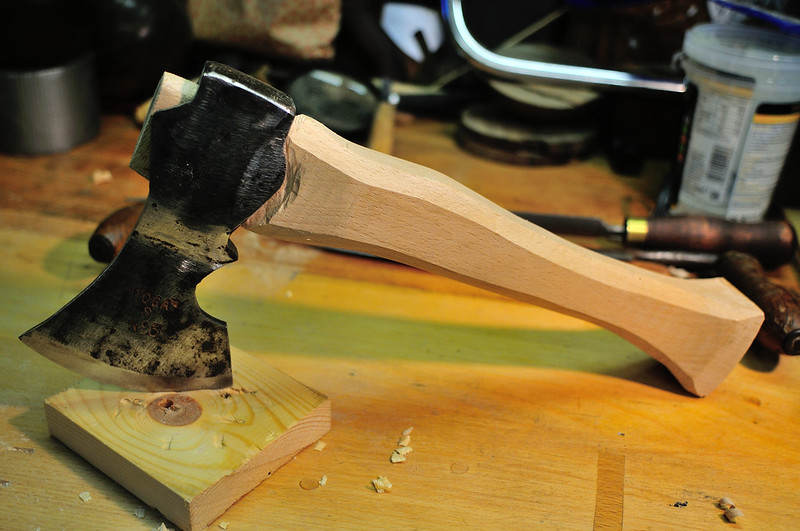SpoonsbySven
Established Member
Hi Folks,
I’ve been meaning to post a few pics of the carving axe I “made” a little while ago. I was inspired by Robin Wood and John Neeman, amazing craftsmen both, and the beautiful carving axe they collaborated to produce (I know John Neeman's not with Neeman Tools anymore, but they're all still making beautiful things). At £260, I’m sure it’s worth every penny, but it’ll be a while before I have enough pennies for one of those. In the meantime, I decided to have a go at making one of my own.
Neeman tools carving axe “Robin Wood edition”: http://www.neemantools.com/en/products/axes/carving-axe-robin-wood
Robin Wood: http://www.robin-wood.co.uk/
I picked up this old Kentish pattern axe at a car boot sale ages ago, and had been meaning to put a new handle on it. Then I thought maybe it was time to be a bit more radical…

Taking inspiration from John Neemand and Robin Woods’ creation, I marked out some lines and set to with a hacksaw:


Then a bench grinder:

I copied this simple jig for grinding the bevel from Tim Manney:http://timmanneychairmaker.blogspot.co.uk/2013/06/carving-axe-edge-geometry-and-grinding.html

(Quite) a few hours of filing and sanding, and here’s the finished head. I spent some time easing all the edges (except the important one!) and couldn’t resist polishing them up...


Finally, a handle from a broken felling axe handle; it was the best piece of seasoned ash I had at the time. I really want to make another handle for it with a greater curve and nice big bulge at the end. I’ve since found just the piece of wood, but this one works pretty well for now...

It's a pleasure to use: a bit lighter than the Gransfors Bruks carving axe, and I guess ideally i'd prefer it a bit heavier. And I think next time I'd make the bevel a bit steeper.
Hope this is of interest.
Cheers,
Sven
PS: When reshaping the cutting edge, and grinding the bevel, a couple of questions occurred to me:
1) is this axe likely to have had a bit of harder steel inserted to form the cutting edge? I can't see any signs of a forge weld in that area. It's a Chip Chop No 1 by Gilpins of Cannock, if that helps.
2) is it likely to have been differentially tempered, with the cutting edge harder than the rest? When grinding the edge, I was very careful not to overheat it, but you can see how much material I removed, and I wonder if I could have ground back past the hardest steel? It's definitely not the hardest of edges, and I wondered whether I should consider having a go at re-hardening and then re-tempering it one day...
I’ve been meaning to post a few pics of the carving axe I “made” a little while ago. I was inspired by Robin Wood and John Neeman, amazing craftsmen both, and the beautiful carving axe they collaborated to produce (I know John Neeman's not with Neeman Tools anymore, but they're all still making beautiful things). At £260, I’m sure it’s worth every penny, but it’ll be a while before I have enough pennies for one of those. In the meantime, I decided to have a go at making one of my own.
Neeman tools carving axe “Robin Wood edition”: http://www.neemantools.com/en/products/axes/carving-axe-robin-wood
Robin Wood: http://www.robin-wood.co.uk/
I picked up this old Kentish pattern axe at a car boot sale ages ago, and had been meaning to put a new handle on it. Then I thought maybe it was time to be a bit more radical…

Taking inspiration from John Neemand and Robin Woods’ creation, I marked out some lines and set to with a hacksaw:


Then a bench grinder:

I copied this simple jig for grinding the bevel from Tim Manney:http://timmanneychairmaker.blogspot.co.uk/2013/06/carving-axe-edge-geometry-and-grinding.html

(Quite) a few hours of filing and sanding, and here’s the finished head. I spent some time easing all the edges (except the important one!) and couldn’t resist polishing them up...


Finally, a handle from a broken felling axe handle; it was the best piece of seasoned ash I had at the time. I really want to make another handle for it with a greater curve and nice big bulge at the end. I’ve since found just the piece of wood, but this one works pretty well for now...

It's a pleasure to use: a bit lighter than the Gransfors Bruks carving axe, and I guess ideally i'd prefer it a bit heavier. And I think next time I'd make the bevel a bit steeper.
Hope this is of interest.
Cheers,
Sven
PS: When reshaping the cutting edge, and grinding the bevel, a couple of questions occurred to me:
1) is this axe likely to have had a bit of harder steel inserted to form the cutting edge? I can't see any signs of a forge weld in that area. It's a Chip Chop No 1 by Gilpins of Cannock, if that helps.
2) is it likely to have been differentially tempered, with the cutting edge harder than the rest? When grinding the edge, I was very careful not to overheat it, but you can see how much material I removed, and I wonder if I could have ground back past the hardest steel? It's definitely not the hardest of edges, and I wondered whether I should consider having a go at re-hardening and then re-tempering it one day...













